.
7.03.2015
COMETWATCH 28 FEBRUARY
Today’s CometWatch entry is a single frame NAVCAM image obtained on 28 February from a distance of 102.6 km from the centre of Comet 67P/Churyumov-Gerasimenko. The image has a resolution of 8.7 m/pixel and measures 9.0 km across.
.
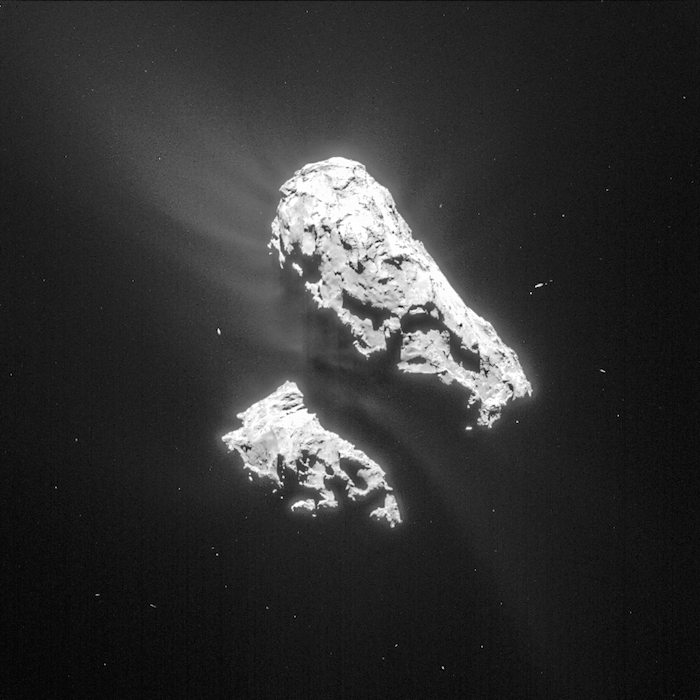
Single frame NAVCAM image of Comet 67P/C-G taken on 28 February from a distance of 102.6 km to the comet centre. The image has been processed to bring out the details of the comet’s activity. The exposure time of the image is 2.6 seconds. Credits: ESA/Rosetta/NAVCAM – CC BY-SA IGO 3.0
.
The view shows the large lobe of the comet to the upper right, with the small lobe to the lower left and the regions adjacent to the comet's neck cast in shadow. This complements the images published earlier this week as CometWatch 26 February and 25-26-27 February, providing yet another perspective on the comet's activity.
Like the four NAVCAM images posted last Wednesday, this image was also taken in support of the observations of the Alice spectrograph. For similar reasons, parts of the image depicting the nucleus are saturated, so we decided again to process the image with a focus on the activity, bringing out the elaborate geometry of the jets of dust emanating from the surface of the nucleus.
.
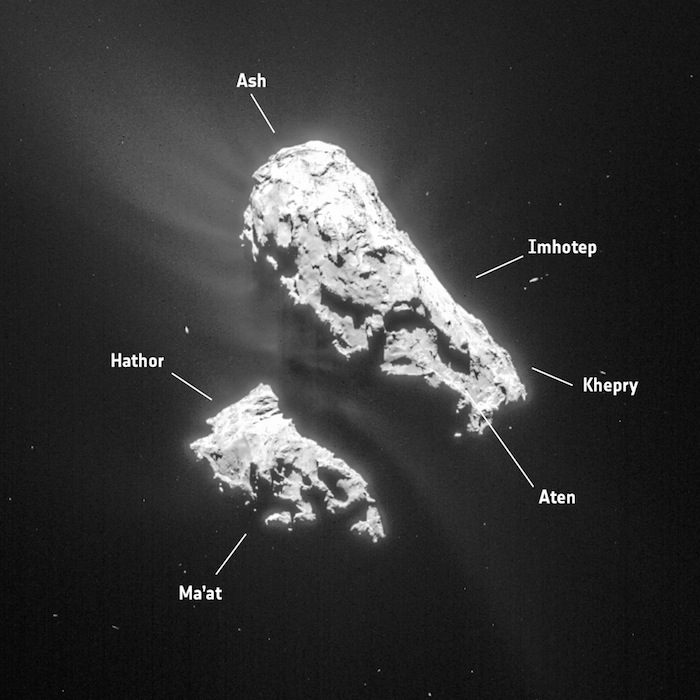
Cropped and annotated version of CometWatch 28 February. Credits: ESA/Rosetta/NAVCAM – CC BY-SA IGO 3.0
.
The curved shape of the outflowing material likely results from a combination of several factors, including the rotation of the comet, differential flows of near-surface gas, and gravitational effects arising due to the uneven shape of the comet. The viewing perspective of the image might also distort the true shape of the outflowing material.
We have also prepared an annotated view of today's CometWatch to help you locate some of the regions shown in the image. You can also find regional maps of Comet 67P/C-G here and here.
The original image is provided below:
.
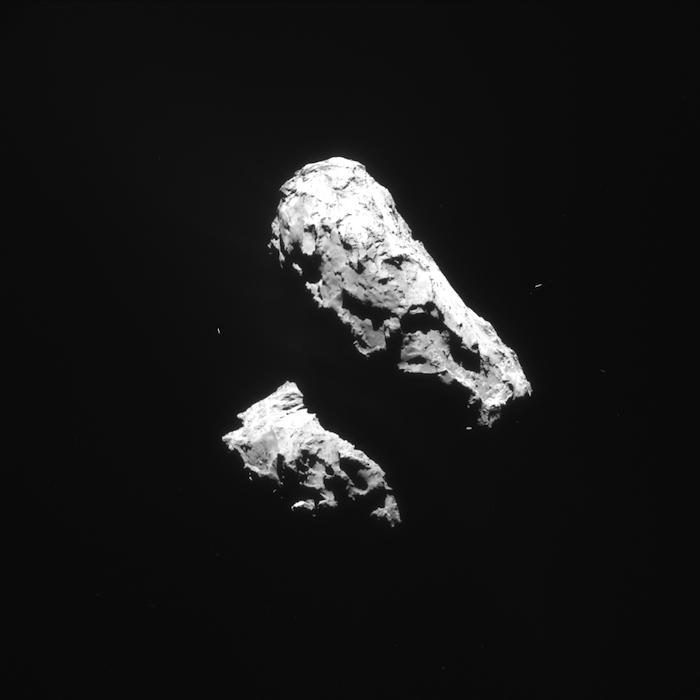
Quelle: ESA
.
Update: 10.03.2015
.
COMETWATCH 6 MARCH
Today’s CometWatch entry is a single frame NAVCAM image obtained on 6 March from a distance of 82.9 km from the centre of Comet 67P/Churyumov-Gerasimenko. The image has a resolution of 7.1 m/pixel and measures 7.2 km across.
.
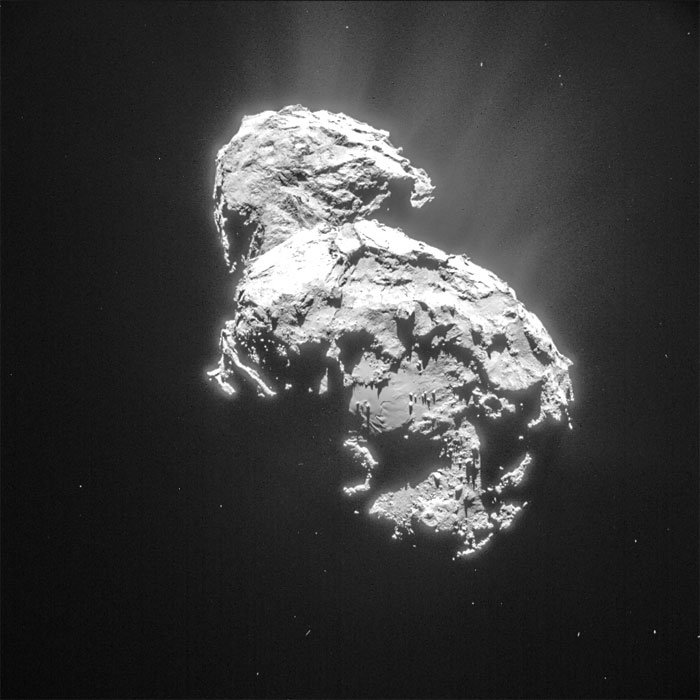
Single frame NAVCAM image of Comet 67P/C-G taken 6 March from a distance of 82.9 km to the comet centre. Credits: ESA/Rosetta/NAVCAM – CC BY-SA IGO 3.0
-
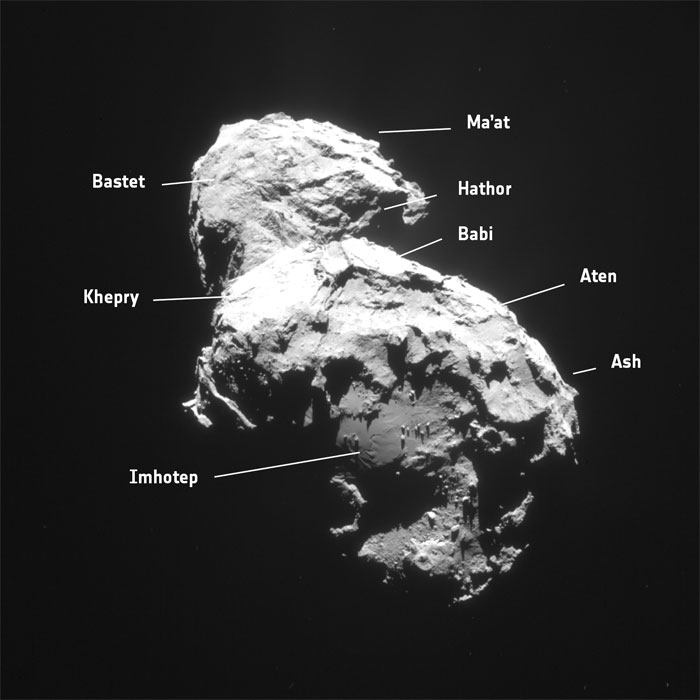
The view shows the underside of the comet’s large lobe in the foreground, with the small lobe in the background. An annotated version of the image is also provided to help identify some of the comet’s regions.
.
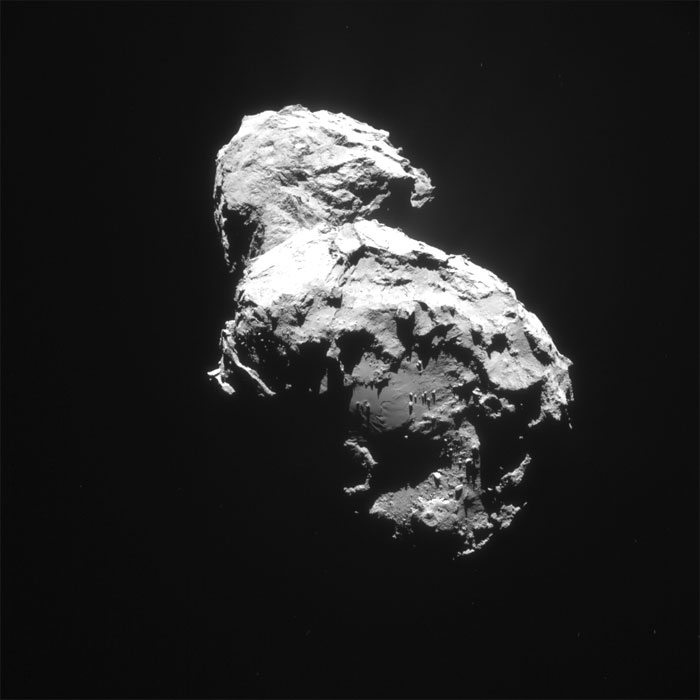
Quelle: ESA
.
WAITING FOR A SIGNAL FROM PHILAE
This week, Rosetta will begin listening for signs that Philae is still “alive”. This report is provided by the German Aerospace Center, DLR.
It would be very lucky if a signal were to be received from Philae at 05:00 CET on 12 March 2015. The lander finally came to rest on 12 November 2014 in a rather shaded location on Comet 67P/Churyumov-Gerasimenko and it needs to receive sufficient energy before it can wake up and begin communicating. This is, however, the first possibility to receive a signal from Philae; therefore, the communication unit on the Rosetta orbiter will be switched on to call the lander.
“Philae currently receives about twice as much solar energy as it did in November last year,” says Lander Project Manager Stephan Ulamec from the German Aerospace Center (Deutsches Zentrum für Luft- und Raumfahrt; DLR).
Today, Comet 67P/Churyumov-Gerasimenko, Rosetta and Philae are 320 million kilometres from the Sun.
“It will probably still be too cold for the lander to wake up, but it is worth trying. The prospects will improve with each passing day,” says Ulamec.
.
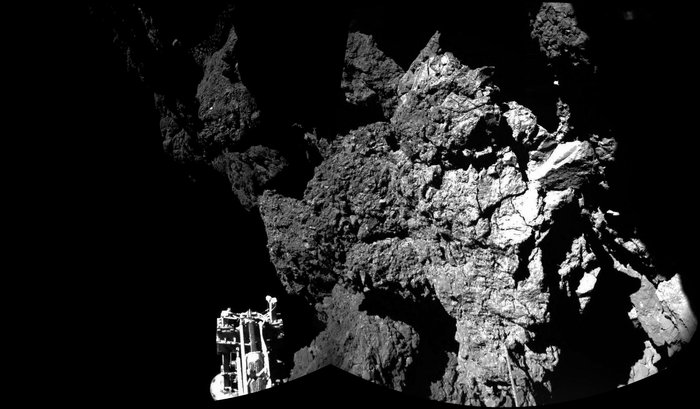
Waking up at the right temperature and energy
Several conditions must be met for Philae to start operating again and allow the DLR Lander Control Center to put it to work. First, the interior of the lander must be at least at –45ºC before Philae can wake up from its winter sleep. At its new landing site – Abydos – only a little sunlight reaches Philae, and the temperatures are significantly lower than at the originally planned landing location. In addition, the lander must be able to generate at least 5.5 watts using its solar panels to wake up. It has not remained idle during hibernation.
“Philae is designed so that, since November 2014, it has been using all the available solar energy to heat up,” says Koen Geurts from the DLR Control Center.
As soon as Philae ‘realises’ that it is receiving more than 5.5 watts of power and its internal temperature is above –45ºC, it will turn on, heat up further and attempt to charge its battery.
Contact during comet daytime
Once awakened, Philae switches on its receiver every 30 minutes and listens for a signal from the Rosetta orbiter. This, too, can be performed in a very low power state.
“At this time, we do not yet know that the lander is awake,” says Geurts. “To send us an answer, Philae must also turn its transmitter – and that requires additional power.”
It could be that the lander has already woken up from its winter sleep some 500 million kilometres away from Earth, but does not yet have sufficient power to communicate with Rosetta, which relays Philae’s signal back to Earth. Philae needs a total of 19 watts to begin operating and allow two-way communication.
Between 12 and 20 March, the Rosetta orbiter is transmitting to the lander and listening for a response. The most likely time for contact is during the 11 flybys where the orbiter’s path puts it in a particularly favourable position with respect to the lander during comet ‘daytime’ – when Philae is in sunlight and being supplied with power by its solar panels. Communication will be attempted continuously because Philae’s environment could have changed since landing in November 2014.
.
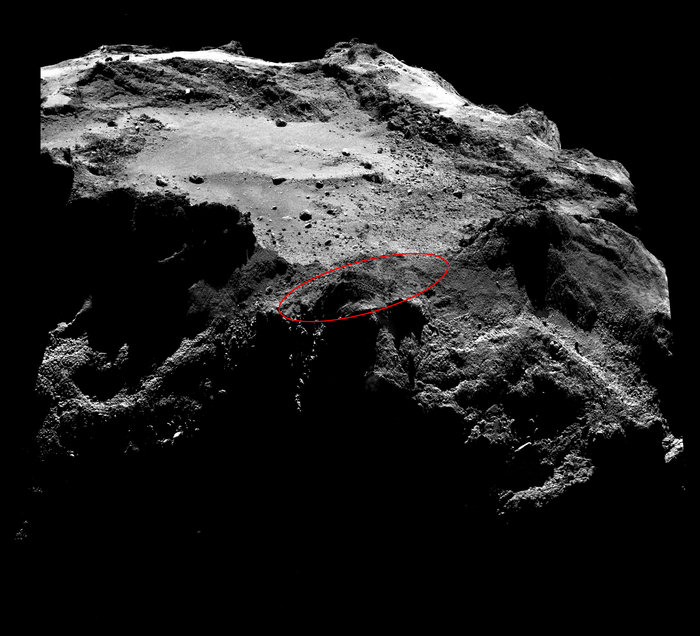
Lander search area. The image is a 2 x 2 mosaic comprising OSIRIS narrow-angle camera images taken on 13 December 2014 from a distance of about 20 km to the centre of the comet.Credits: ESA/Rosetta/MPS for OSIRIS Team MPS/UPD/LAM/IAA/SSO/INTA/UPM/DASP/IDA
.
Preparation for all eventualities
So far, Philae’s exact location has not been identified on images acquired by the Optical, Spectroscopic, and Infrared Remote Imaging System (OSIRIS) on board the Rosetta orbiter, so the operations team at DLR is currently working with the information they have from the lander’s cameras: the Comet nucleus Infrared and Visible Analyser (CIVA) and the ROsetta Lander Imaging System (ROLIS), along with the knowledge gained from the solar energy conditions experienced in November.
“However, we assume that the solar panels of Philae are shadowed but, by what, we cannot see in the previous images,” says Geurts.
The DLR engineers have therefore sent new commands to the lander that optimise the heating and provide energy savings to improve its chances of communication with Earth. Even if Philae does not have enough energy yet to answer, it could receive and execute these commands. This is referred to as ‘blind commanding’ by the engineers, because the lander is initially very unlikely give them feedback. These procedures were tested on the ground model at the DLR Microgravity User Support Center (MUSC). Even in the event that the rechargeable battery on board Philae did not survive the cold phase, the engineers are prepared.
“We are working to ensure that we can operate the lander and its instruments at least during the comet’s daytime, when it is in direct sunlight,” says Geurts.
Waiting for the health check
Once Philae wakes up and can also transmit, it will first send data about its ‘health’ to Earth.
“We will then evaluate the data. What is the state of the rechargeable battery? Is everything on the lander still functioning? What is the temperature? How much energy is it receiving?” says Geurts.
The scientific work with the 10 instruments on board Philae also depends on these results. If sufficient energy cannot be stored in the battery, the solar energy available during the comet daytime will determine whether a reduced version of the measurements can be performed. Currently, scientists believe that Philae is in sunlight for 1.3 hours. A day on 67P/Churyumov-Gerasimenko lasts 12.4 hours. If the battery can be charged as planned, measurements can be carried out during the comet night, enabling, for example, long-term measurements. What instrument is used and when will be determined by the team of scientists.
“If we cannot establish contact with Philae before 20 March, we will make another attempt at the next opportunity,” says Ulamec. “Once we can communicate with Philae again, the scientific work can begin.”
As the distance to the Sun decreases, the energy that the lander collects with its solar panels is becoming greater.
Quelle: ESA
-
Update: 13.03.2015
.
THE PHILAE COMET LANDER MIGHT HAVE ENOUGH POWER TO WAKE UP
IN NOVEMBER, A spacecraft made a dramatic, first-ever landing on a comet—three times. After the Philae lander touched down on comet 67P/Churyumov-Gerasimenko, the harpoons that were supposed to latch it onto the surface didn’t fire, and instead, the spacecraft bounced back into space before returning to the comet. Another shorter hop then took it to its current, shady resting spot. Since then, the Philae lander has been slumbering in the cold and dark some 286 million miles away, with only meager recharging from its solar panels. Now, with warmer and brighter days ahead, it’s time to see if the Philae lander is awake and ready to get back to work. Just don’t expect anything too soon.
Today, for the first time since it started napping, mission engineers have begun trying to communicate with Philae, which exhausted its batteries soon after landing. After four months, the orbit of the European Space Agency’s Rosetta spacecraft, which has been circling comet 67P, is now aligned with Philae so that they can talk to each other—as long as Philae has eked out enough power and warmth from its limited sunlight. “We don’t think we’ll hear anything just yet, but we cannot be very sure,” says Koen Geurts, the technical manager of the Philae team.
Lacking communication with Philae, scientists still don’t know exactly where it is and what its surroundings are like. Engineers have used Rosetta’s cameras to narrow down its location, but the orbiting spacecraft is currently too far away to spot the lander. Rosetta will swoop in closer in July, but as of now, engineers can only estimate that Philae is only getting 1.3 hours of sunlight for each 12.4-hour day on the comet. For the lander to wake up, its solar panels have to be turning those meager hours of sunlight into 5.5 watts of power. And to send and receive signals from Rosetta, it needs 19 watts. Philae also has to be warmer than -49˚F to work. “We do not expect that this is already the case,” Geurts says. “We think Philae is still cold.” In its shadowy hole, Philae’s temperature may have dropped to as low as -150˚F, and even though comet 67P is getting closer to the sun—Philae’s getting twice as much solar energy than it did in November—the spacecraft probably needs more time to thaw.
But as Philae is still out-of-sight, it could turn out to be in a sunnier place, charged up and ready to go. When or if it wakes up, engineers will take a couple weeks to make sure it’s still working. At least at first, it may be too cold for Philae to fully charge its battery, which will limit how much science it can do. “Without the battery, science activity can only last as long as sunlight,” Geurts says. That means Philae won’t be able to drill into the icy comet and find out exactly what it’s made of. But it should still be able to do lower-intensity jobs like take pictures, measure the comet’s magnetic field and seismic activity, and sniff the surrounding gases.
Now that Rosetta and Philae have open lines of communication, mission controllers have commanded the orbiter to start sending signals to Philae starting at 12:00 am EDT. They’ll continue trying to contact Philae until March 20, when Rosetta’s changing orbit puts it out of position. “If we don’t hear anything in this opportunity, then we hope for the next one,” Geurts says. That next window of opportunity will come between April 13 and 20. If nothing then, several shorter windows open in May, and a longer period opens in June.
On August 13, the comet will reach its closest point to the sun—and if the European Space Agency hasn’t heard from it by then, they’ll call it quits. With increasing sunlight, ice will sublimate into gas, creating jets and gassy gusts that can knock Philae out. “If we haven’t heard something by the end of July or beginning of August, it can be excluded we will hear something again,” Geurts says. “Either Philae didn’t survive the cold temperatures, some critical system broke down, or Philae fell over because of comet activity.”
But chances are good that it will wake up again—most likely in April or May, if Geurts had to hazard a guess. And if it wakes up tomorrow? “I will be very happy of course,” he says. “No doubt about that.”
Quelle: WIRED
-
Update: 14.03.2015
.
Auf Empfang für Philaes Signal
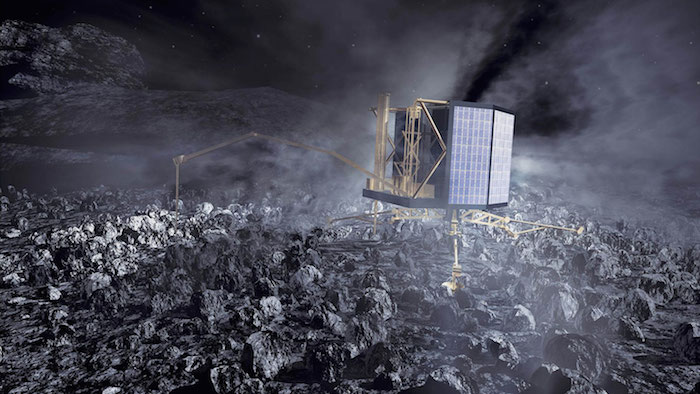
Es wäre viel Glück im Spiel, wenn am 12. März 2015 um 5 Uhr direkt ein Signal von Lander Philae zu hören wäre - schließlich steht der Lander an einem recht schattigen Platz auf dem Kometen Churyumov-Gerasimenko und muss erst genügend Energie tanken, bevor er aufwachen und sich melden kann. Dennoch: Die erste Möglichkeit, dass Philae sich meldet, besteht, und deshalb wird am 12. März die Kommunikationseinheit am Rosetta-Orbiter eingeschaltet, die den Lander rufen wird. "Philae erhält zurzeit ungefähr doppelt so viel Sonnenenergie wie im November vergangenen Jahres", sagt Lander-Projektleiter Dr. Stephan Ulamec vom Deutschen Zentrum für Luft- und Raumfahrt (DLR). Immerhin sind Komet Churyumov-Gerasimenko und sein Begleiter Philae nur noch 300 Millionen Kilometer von der Sonne entfernt. "Wahrscheinlich wird es trotzdem noch zu kalt für den Lander sein, um aufzuwachen – aber ein Versuch ist es wert. Die Chancen steigen mit jedem Tag."
Aufwachen bei der richtigen Temperatur und Energie
Gleich mehrere Bedingungen müssen passen, damit Philae wieder in Betrieb geht und im Lander-Kontrollzentrum des DLR die Arbeit mit dem Lander aufgenommen werden kann. Zunächst muss es im Inneren des Landers wärmer als minus 45 Grad Celsius werden, bevor Philae aus seinem Winterschlaf erwachen kann. An seinem neuen Landeplatz Abydos erreicht ihn nur wenig Sonne, und so waren die Temperaturen bisher deutlich niedriger als notwendig. Zudem muss Philae über seine Solarpaneele mindestens mit 5,5 Watt versorgt werden, damit er aufwacht. Untätig bleibt er dennoch nicht in seinem Winterschlaf: "Philae ist so konstruiert, dass er seit November 2014 jedes bisschen Sonnenenergie dafür nutzt, sich aufzuheizen", erläutert Dr. Koen Geurts vom DLR-Kontrollzentrum. Sobald er "merkt", dass er mehr als 5,5 Watt Energie erhält und seine eigene Temperatur über minus 45 Grad Celsius liegt, schaltet Philae sich ein, heizt sich weiterhin auf und versucht zusätzlich, seine Batterie zu laden.
Kontakt am Kometentag
Einmal aufgewacht, schaltet Philae alle 30 Minuten seinen Empfänger ein und lauscht, ob er Rosettas Signale hört. Auch dies kann er bei einem noch sehr niedrigen Energiestand durchführen. "Zu diesem Zeitpunkt wissen wir aber noch nicht, dass er wach ist", sagt DLR-Ingenieur Koen Geurts. "Um uns eine Antwort zu schicken, muss Philae nämlich auch seinen Sender einschalten – und dafür benötigt er zusätzliche Energie." Es könnte also sein, dass der Lander zwar in 500 Millionen Kilometern Entfernung bereits aus seinem Winterschlaf aufgewacht ist, seine Kraft aber noch nicht ausreicht, um sein Team auf der Erde darüber zu informieren. Insgesamt 19 Watt benötigt Philae, damit er in Betrieb gehen und die Kommunikation aufnehmen kann. Zunächst einmal bis zum 20. März wird Orbiter Rosetta den Lander anfunken und auf eine Reaktion horchen. Am wahrscheinlichsten ist der Kontakt bei elf Vorbeiflügen, bei denen der Orbiter in einer besonders günstigen Konstellation zum Lander während eines Kometentages seine Bahn zieht – denn nur dann steht Philae im Sonnenlicht und wird über seine Solarpaneele mit Energie versorgt. Versucht wird die Kommunikation trotzdem kontinuierlich, weil Philaes Umgebung sich seit der Landung im November 2014 geändert haben könnte.
Vorbereitung für alle Fälle
Bisher konnte Philae und seine genaue Lage noch nicht auf Bildern der OSIRIS-Kamera identifiziert werden, und so arbeitet das Operations-Team im DLR derzeit mit den Informationen, die ihnen die Aufnahmen der CIVA- und der ROLIS-Kamera sowie die Erfahrungswerte zur Solarenergie im November bieten. "Wir gehen aber davon aus, dass die Solarpaneele von Philae durch etwas abgeschattet werden, was wir auf den bisherigen Bildern nicht sehen können." Als erstes senden die DLR-Ingenieure deshalb immer wieder neue Kommandos an den Lander, die das Heizen optimieren und den so gesparten Energieaufwand für seine Kommunikation zur Erde zur Verfügung stellen. Selbst wenn Philae noch nicht genügend Energie hat, um zu antworten – er könnte diese Kommandos empfangen und ausführen. "Blindes Kommandieren" nennen die Ingenieure dies, denn der Lander wird ihnen zunächst sehr wahrscheinlich keine Rückmeldung geben. Getestet wurden diese Prozeduren am Bodenmodell des DLR-Nutzerzentrums für Weltraumexperimente (MUSC). Auch für den Fall, dass die aufladbare Batterie von Philae die Kältephase nicht überstanden hat, wappnen sich die Ingenieure. "Wir arbeiten gerade daran, dass wir mit dem Lander und den Instrumenten dann zumindest während der Kometentage und somit bei direkter Sonnenbestrahlung arbeiten können."
Warten auf den Gesundheitscheck
Erst wenn Philae nicht nur aufwacht, sondern auch senden kann, schickt er erste Daten zu seinem "Gesundheitszustand" zur Erde. "Diese Daten werden wir dann auswerten: Wie geht es der aufladbaren Batterie? Funktioniert noch alles am Lander? Welche Temperatur herrscht? Wieviel Energie erhält er?", sagt Koen Geurts. Abhängig von diesen Ergebnissen ist auch die wissenschaftliche Arbeit mit den zehn Instrumenten an Bord von Philae. Kann die Batterie keine Energie speichern oder nur wenig, bestimmt die Sonnenenergie während des Kometentages, ob man eine abgespeckte Version der Messungen durchführen kann. Zurzeit gehen die Wissenschaftler davon aus, dass Philae 1,3 Stunden lang im Sonnenlicht steht. Insgesamt dauert ein Kometentag auf Churyumov-Gerasimenko 12,4 Stunden. Lädt die Batterie hingegen wie geplant auf, kann auch in der Kometennacht gearbeitet werden – so könnten beispielsweise Langzeitmessungen zum Zuge kommen. Welches Instrument wann zum Einsatz kommt, legt das Team der beteiligten Wissenschaftler gemeinsam fest.
"Sollten wir bis zum 20. März keinen Kontakt zu Philae aufbauen können, werden wir dies bei der nächsten Gelegenheit wiederholen", sagt Philae-Projektleiter Stephan Ulamec vom DLR. Mit zunehmender Annäherung an die Sonne wird auch die Energie größer, die der Lander über seine Solarpaneele erhält. "Sobald wir mit Philae wieder kommunizieren können, kann die wissenschaftliche Arbeit beginnen."
Die Mission
Rosetta ist eine Mission der ESA mit Beiträgen von ihren Mitgliedsstaaten und der NASA. Rosettas Lander Philae wird von einem Konsortium unter der Leitung von DLR, MPS, CNES und ASI beigesteuert.
Quelle: DLR
---
OSIRIS DETECTS HINTS OF ICE IN COMET’S NECK
This post is based on information provided by the OSIRIS team at the Max Planck Institute for Solar System Research (MPS) in Germany.
If it could be seen with the naked human eye, the nucleus of Comet 67P/Churyumov-Gerasimenko would be a dark grey all over. With its array of specialised filters, however, Rosetta’s scientific imaging system OSIRIS can discern tiny differences in reflectivity at different wavelengths across the comet’s surface. In turn, these differences can reveal clues as to the local composition of the comet.
The image shown here focuses on the Hapi region of the comet. Hapi is located in the neck between the comet’s two lobes and has in the past months proven to be particularly active, the source of many of the spectacular jets of dust and gas seen in the wider-view images.
-
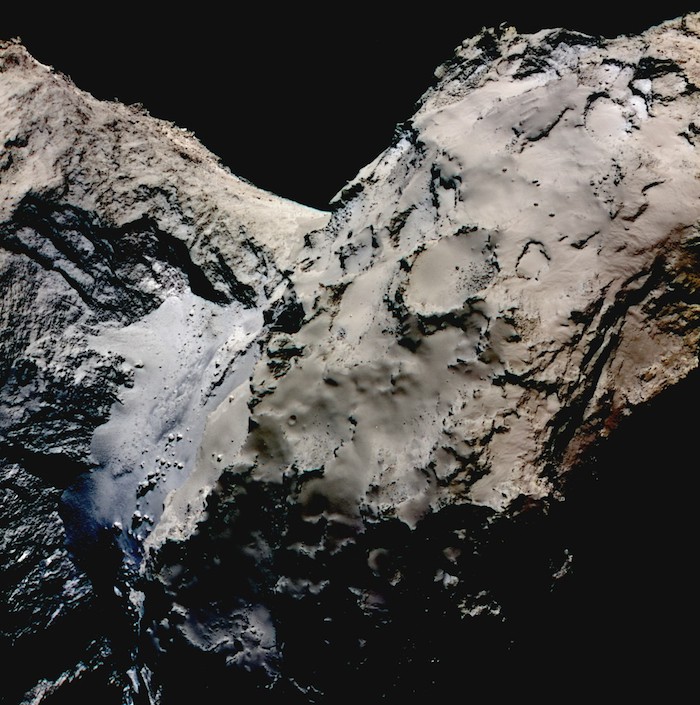
False colour image showing the smooth Hapi region connecting the head and body of Comet 67P/Churyumov-Gerasimenko. Differences in reflectivity have been enhanced in this image to emphasise the blue-ish colour of the Hapi region. The scientific data was acquired on 21 August 2014 by the scientific imaging system OSIRIS with broad-band filters centred at 989, 700, and 480 nanometres. These images have been combined here as red, green, and blue, respectively, and the composite has been processed to enhance the slight colour differences. During these observations Rosetta was 70 km from the comet, and the corresponding spatial resolution is 1.3m per pixel. Credits: ESA/Rosetta/MPS for OSIRIS Team MPS/UPD/LAM/IAA/SSO/INTA/UPM/DASP/IDA
Three separate OSIRIS images were taken through three broad-band filters centred at 989, 700, and 480 nanometres, respectively. These were then combined as red, green, and blue, respectively, to make a colour image.
Because the images were taken sequentially, there was some comet rotation and spacecraft motion between them, meaning that accurately aligning the images before they are combined is non-trivial. Small errors in this process can lead to small-scale colour features which are not real, so it is important to focus on the large-scale colour variations between Hapi and neighbouring regions as an indication of broad compositional differences.
It is clear from this image that indeed Hapi reflects red light less effectively than most other visible regions on the comet and thus appears slightly blue-ish. Importantly, this blue-ish colouring might point to the presence of frozen water ice at or just below the dusty surface of Hapi.
“Even though the colour variations on 67P’s surface are minute, they can give us important clues,” says OSIRIS Principal Investigator Holger Sierks from the Max Planck Institute for Solar System Research (MPS) in Germany.
The scientists believe that the distinct reflectivity properties of Hapi hint at a higher abundance of frozen water at or near the surface in this region. The colour differences are very slight and could be explained by the presence of just small amounts of water ice peeking through the dusty shroud that covers much of 67P/C-G at the moment. While some dust present on the surface may be due to local depositions of dust associated with activity, some is also likely left over from the comet’s last passage around the Sun. Much of this dust shroud is expected to be blown away as the comet becomes even more active closer to the Sun later this year.
Previous missions had observed similar features on comets Hartley-2 and Tempel-1, and also associated a blue-ish spectrum with the presence of frozen water. While OSIRIS can only take images in a limited number of spectral bands, Rosetta is equipped with other instruments including VIRTIS, capable of making an unambiguous identification the spectral signature of frozen water molecules in infrared reflection.
“We are excited to see whether our suspicion will be confirmed,” says Sierks.
As the smoother surface of the Hapi region gives way to the more rugged terrain of the surrounding areas, the reflectivity changes, too.
“We see that the reflectivity properties are closely correlated to the surface morphology,” says OSIRIS scientist Sonia Fornasier from the Paris Observatory.
The Hapi region differs from the rest of 67P/C-G’s surface in many respects. Not only is it much smoother, it is one of the main sources of activity in the comet’s northern hemisphere at the moment – early dust jets originated there.
“During perihelion, when 67P heats up significantly, Hapi will be hidden in northern polar night. Outbound on the comet’s orbit, from March 2016, Hapi will receive solar heat again,” says Fornasier.
“At this large distance from the Sun, it will then be very cold. Hapi might therefore be a region that has been able to retain ices on its surface during past orbits around the Sun and has thus enough ‘fuel’ left to create the fireworks of activity we have witnessed in the past months.”
---
OUT OF THE SHADOW – COMETWATCH 9 MARCH
Today’s CometWatch entry was captured on 9 March at a distance of 71.9 km from the centre of Comet 67P/Churyumov-Gerasimenko.
-
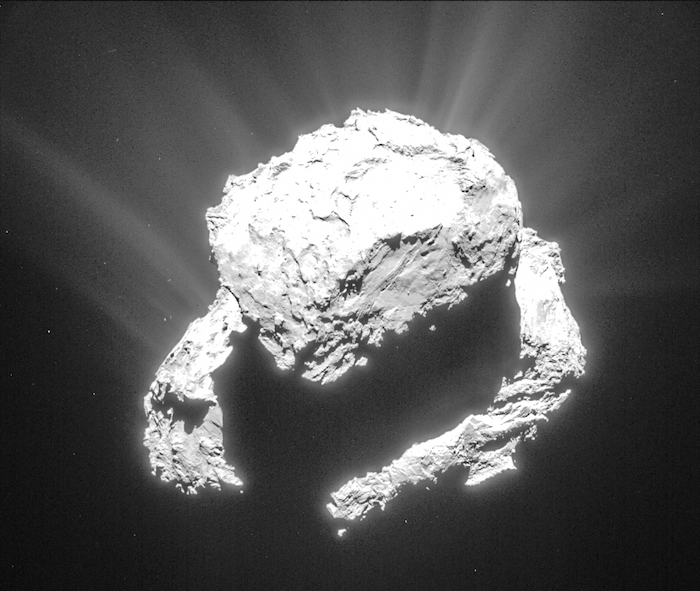
Cropped and processed single frame NAVCAM image of Comet 67P/C-G taken 9 March from a distance of 71.9 km to the comet centre. Credits: ESA/Rosetta/NAVCAM – CC BY-SA IGO 3.0
.
The scale is 6.1 m/pixel and the image measures 6.3 km across (note that the processed version above is slightly cropped in the vertical direction for aesthetic purposes; the original provided at the end of the post is uncropped). As with recent previous entries, these Alice context images are currently slightly over-exposed on some parts of the comet, so we have pushed the contrast to focus on the activity of the comet. Indeed, many jets can be seen against the dark backdrop.But, at the same time, this view provides one of the clearest views yet of a region on the small comet lobe that in many previously published images has been partly cast in shadow. Thus, included in this post for comparison is roughly the same region seen at different angles/illumination conditions on 30 October 2014 and 18 January 2015.
-
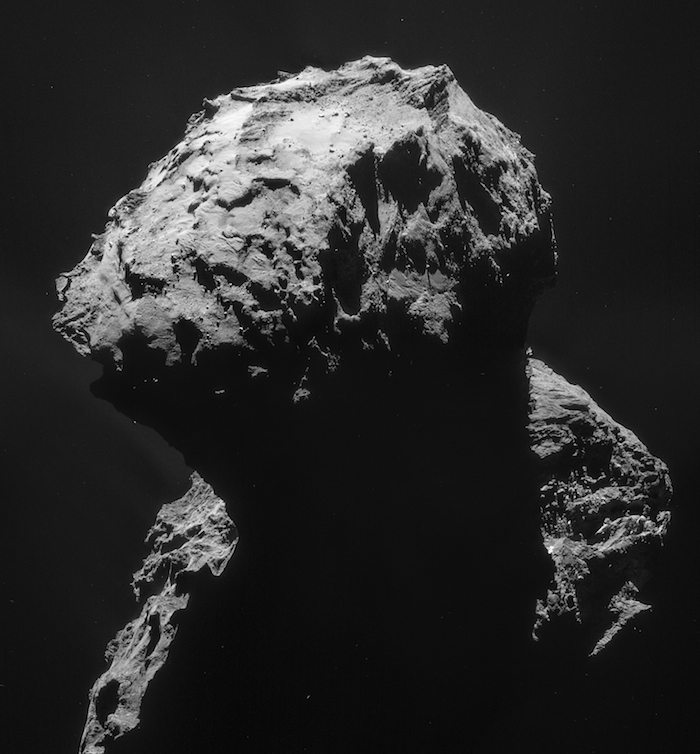
Four image mosaic comprising images taken on 18 January 2015 Credits: ESA/Rosetta/NAVCAM – CC BY-SA IGO 3.0
.
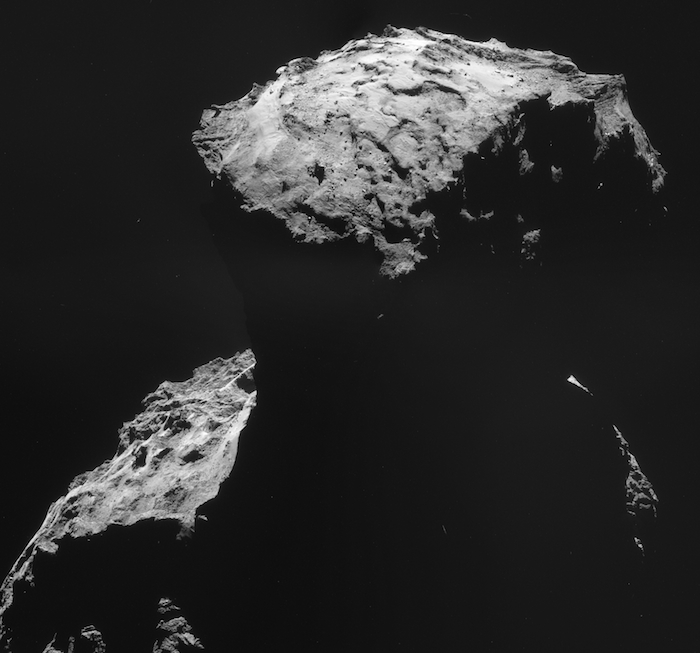
Four-image mosaic of Comet 67P/C-G on 30 October. Credits: ESA/Rosetta/NAVCAM -CC BY-SA IGO 3.0
.
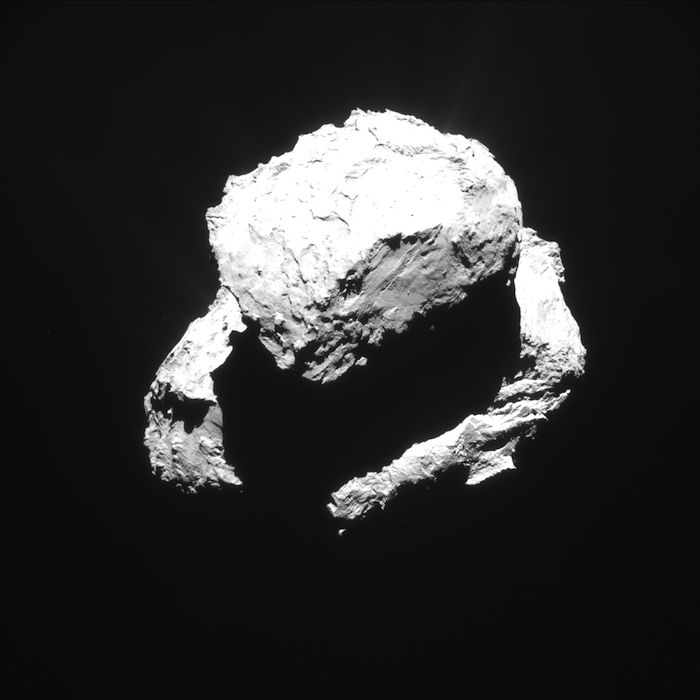
Quelle: ESA
.
Update: 15.03.2015
.
Rosetta: Hinweise auf Eis am Hals des Kometen
Leicht bläulich gefärbt zeigt sich ein Teil des Halses des Kometen 67P/Churyumov-Gerasimenko. Das lässt sich Aufnahmen des Kamerasystems OSIRIS entnehmen.
Die Region Hapi auf dem Hals des Rosetta-Kometen 67P/Churyumov-Gerasimenko reflektiert rotes Licht weniger effektiv als die meisten anderen Regionen. Sie erscheint deshalb leicht bläulich. In den vergangenen Monaten hatte sich dieser Bereich zudem als besonders aktiv erwiesen: Viele der Fontänen aus Staub und Gas, die der Komet ins All spuckt, nahmen dort ihren Ursprung. Wissenschaftler des OSIRIS-Teams nutzen Aufnahmen, die mit Hilfe der Farbfilter des Kamerasystems an Bord der Raumsonde Rosetta entstanden sind, um die Reflektionseigenschaften der Kometenoberfläche zu untersuchen. Ihre Analysen bestätigen, dass die Hapi-Region einzigartig ist. Ihre bläuliche Färbung deutet daraufhin, dass dort gefrorenes Wasser mit dem oberflächlichen Staub vermischt ist.
.
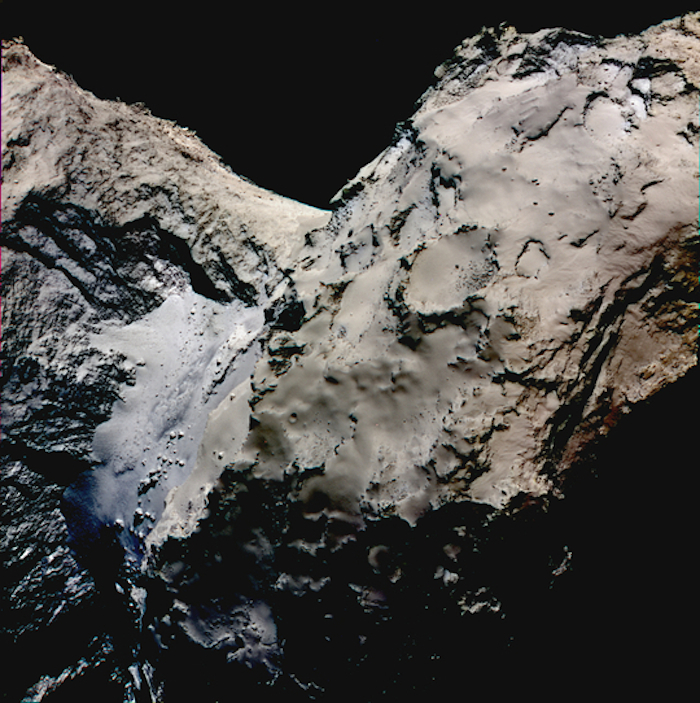
Mit dem menschlichen Auge betrachtet ist der Komet 67P/Churyumov-Gerasimenko grau – überall grau, auch in der Hapi-Region. Mit seinen Farbfiltern kann das Kamerasystem OSIRIS jedoch kleinste Unterschiede in der Reflektivität erkennen. Dazu lichten Forscher des OSIRIS-Teams dieselbe Region auf der Kometenoberfläche nach einander mit Hilfe verschiedener Farbfilter ab. Falls die Region in einer dieser Aufnahmen heller erscheint als auf einer anderen, reflektiert sie das Licht dieser Wellenlänge besser und erscheint somit hervorgehoben in dieser Farbe.
„Auch wenn die Farbvariationen auf der Oberfläche von 67P klein sind, können sie wichtige Hinweise enthalten“, so Holger Sierks vom Max-Planck-Institut für Sonnensystemforschung (MPS) in Göttingen, Leiter des OSIRIS-Teams. In einer aktuellen Analyse hebt sich die Hapi-Region deutlich vom Rest des Kometen ab. Während die meisten Bereiche von 67P ein leicht rötliches Reflektionsspektrum zeigen, wie dies für Kometenkerne und andere primitive Körper wie etwa Asteroiden üblich ist, ist die Reflektion von rotem Licht aus dieser Region etwas geringer.
„Wir wissen, dass die Reflexionseigenschaften direkt mit der Oberflächenmorphologie zusammenhängen", sagt OSIRIS-Wissenschaftlerin Sonia Fornasier vom Pariser Observatorium. Wo die glatte Oberfläche der Hapi-Region der zerklüfteteren Landschaft angrenzender Gebiete weicht, ändern sich auch die Reflektionseigenschaften. Nach Ansicht der Wissenschaftler deuten ihre Messdaten darauf hin, dass in der Hapi-Region gefrorenes Wasser verstärkt an oder nahe der Oberfläche auftritt. Frühere Weltraummissionen zu den Kometen 103P/Hartley 2 und 9P/Tempel 1 hatten ein ähnliches Verhalten beobachtet und das bläuliche Spektrum mit dem Vorkommen gefrorenen Wassers in Verbindung gebracht.
OSIRIS kann das reflektierte Licht des Kometen mit Hilfe der Farbfilter nur in einer begrenzten Anzahl von Wellenlängenbereichen darstellen. Um oberflächliches Eis direkt zu identifizieren, ist die Raumsonde Rosetta deshalb mit weiteren Instrumenten ausgestattet. Das Spektrometer VIRTIS etwa kann die spektralen Fingerabdrücke von Wassermolekülen eindeutig zuordnen. „Wir sind gespannt, ob sich unsere Hinwiese durch solche Messungen bestätigen werden“, so Sierks.
Die Region Hapi unterscheidet sich von dem Rest der Kometenoberfläche in vielerlei Hinsicht. Sie ist nicht nur viel glatter, sondern auch einer der Hauptausgangsorte für Aktivität. Einige der ersten Staub- und Gasfontänen, die der Komet ins All spuckte, hatten dort ihren Ursprung. "Wenn Komet 67P im August dieses Jahres seinen kleinsten Abstand zur Sonne erreicht, wird er sich stark aufheizen. Dies gilt jedoch nicht für die Hapi-Region, die in dieser Zeit im Dunkeln bleibt und eine Art Polarnacht durchlebt“, so Fornasier. „Erst ab März 2016 wird Sonnenlicht wieder auf die Hapi-Region treffen. Es ist deshalb durchaus denkbar, dass während vergangener Umläufe um die Sonne oberflächliches Eis in dieser Region überdauern konnte. Dies könnte der Grund sein, warum Hapi noch genug „Reserven“ hat, um das Aktivitätsfeuerwerk, das wir in den vergangenen Monaten beobachten konnten, zu speisen.“
Rosetta ist eine Mission der Europäischen Weltraumagentur ESA mit Beiträgen der Mitgliedsstaaten und der amerikanischen Weltraumagentur NASA. Rosettas Landeeinheit Philae wurde von einem Konsortium unter Leitung des Deutschen Zentrums für Luft- und Raumfahrt (DLR), des Max-Planck-Instituts für Sonnensystemforschung (MPS) und der französischen und italienischen Weltraumagentur (CNES und ASI) zur Verfügung gestellt. Rosetta ist die erste Mission in der Geschichte, die einen Kometen anfliegt, ihn auf seinem Weg um die Sonne begleitet und eine Landeeinheit auf seiner Oberfläche absetzt.
Das wissenschaftliche Kamerasystem OSIRIS wurde von einem Konsortium unter Leitung des Max-Planck-Instituts für Sonnensystemforschung in Zusammenarbeit mit CISAS, Universität Padova (Italien), Laboratoire d'Astrophysique de Marseille (Frankreich), Instituto de Astrofísica de Andalucia, CSIC (Spanien), Scientific Support Office der ESA (Niederlande), Instituto Nacional de Técnica Aeroespacial (Spanien), Universidad Politéchnica de Madrid (Spanien), Department of Physics and Astronomy of Uppsala University (Schweden) und dem Institut für Datentechnik und Kommunikationsnetze der TU Braunschweig gebaut. OSIRIS wurde finanziell unterstützt von den Weltraumagenturen Deutschlands (DLR), Frankreichs (CNES), Italiens (ASI), Spaniens (MEC) und Schwedens (SNSB).
Quelle: Max-Planck-Institut für Sonnensystemforschung
.
Update: 17.03.2015
.
COMETWATCH: FOCUS ON HAPI’S BOULDERS
With today’s CometWatch entry, we take a dip into the past, presenting a single frame NAVCAM image obtained on 17 October 2014, when Rosetta was in a bound orbit around Comet 67P/Churyumov-Gerasimenko. The image was taken from a distance of 10.0 km from the centre of the comet, and at that distance, the resolution of NAVCAM is 85 cm/pixel and the full field of view spans 870 metres.
.
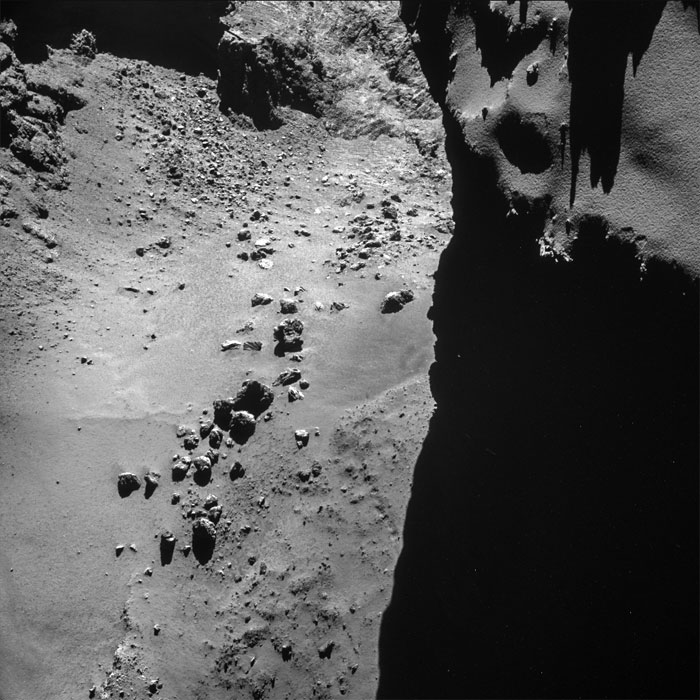
The Hapi region on the 'neck' of Comet 67P/C-G, viewed by Rosetta's navigation camera (NAVCAM) on 17 October 2014 from a distance of 10.0 km from the comet centre. The image has been processed in Lightroom to enhance the surface textures and to eliminate vignetting in the lower-left corner. Credits: ESA/Rosetta/NAVCAM – CC BY-SA IGO 3.0
The image offers a stunning view on the row of ‘boulders’ lying in the Hapi region on the comet’s neck. A small portion of the Ma’at region on the smaller ‘head’ lobe of the comet is visible in the top-right corner, casting a shadow down the lower right side.
As shown in this graphic featuring a full comet view taken by NAVCAM on 19 August 2014 from a distance of about 79 km from the centre, Hapi is a narrow region connecting the large and small lobes of the comet. The smooth appearance of Hapi suggests that it is likely covered in dust and other material that might have fallen from either of the two lobes, including the small and large boulders featured in detail in today’s CometWatch.
,
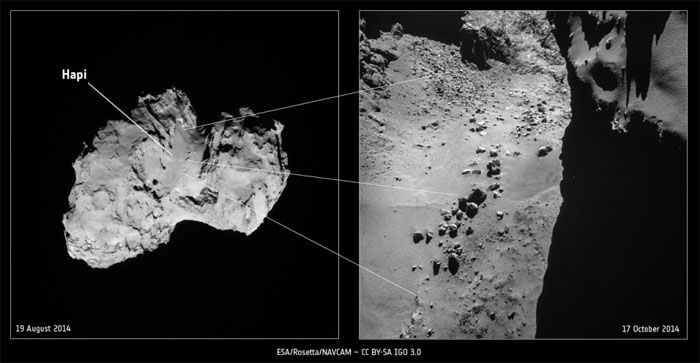
Focus on Hapi's boulders. Credits: ESA/Rosetta/NAVCAM – CC BY-SA IGO 3.0
Hapi also appears to be the most active region on the comet’s surface so far, and last week’s colour image from OSIRIS shows this region to be somewhat bluer than the rest of the comet, suggestive of ice just below the surface. Observations with the VIRTIS imaging spectrometer should be able to confirm or contradict this hypothesis.
.
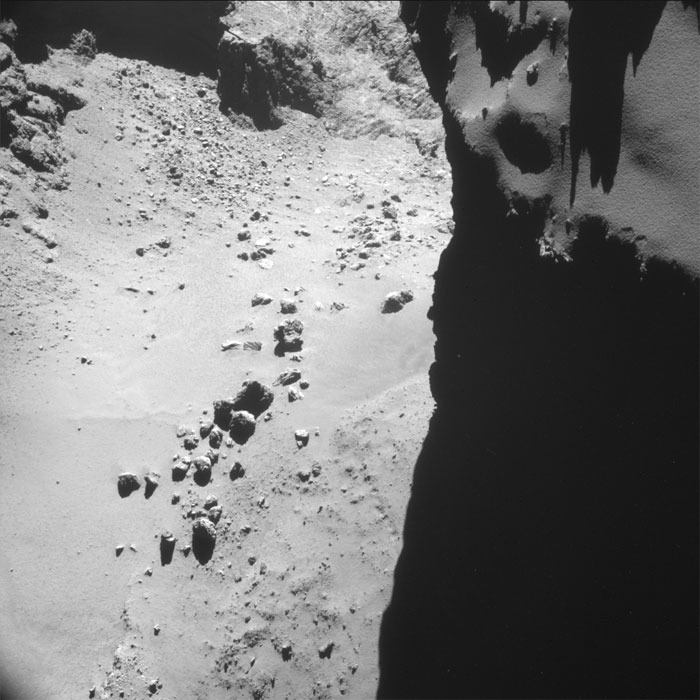
Quelle: ESA
-
Update: 19.03.2015
.
COMETWATCH 14 MARCH
Today’s CometWatch entry was taken by Rosetta's Navigation Camera (NAVCAM) on 14 March at a distance of 85.7 km from the centre of Comet 67P/Churyumov-Gerasimenko.
.
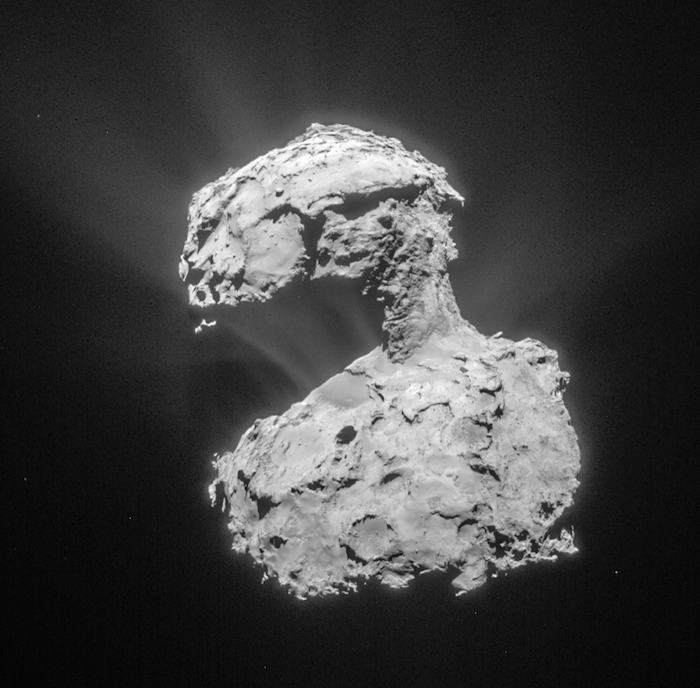
Cropped and processed single frame NAVCAM image of Comet 67P/C-G taken on 14 March 2014 from a distance of 85.7 km to the comet centre. Credits: ESA/Rosetta/NAVCAM – CC BY-SA IGO 3.0
This single frame NAVCAM image has been processed in Lightroom to bring out the comet's activity and then slightly cropped. The scale is 7.3 m/pixel and the image measures 6.4 × 6.3 km. The original picture (uncropped) is provided at the end of the post and measures 7.5 km across.
In this orientation, the comet's small lobe is up and the large lobe down. On the comet's neck, the Anuket region can be seen on the right, while Hathor on the left is shielded from visibility due to a combination of shadows cast by the small lobe and of the nebulosity arising from activity near the neck region. The comet's glowing 'atmosphere' is particularly pronounced around the small lobe and neck.
.
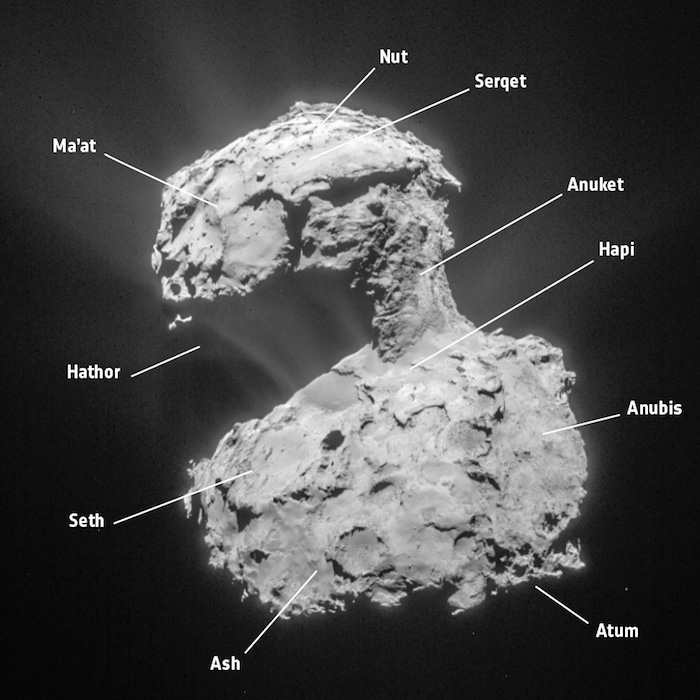
Some of the regions on the surface of Comet 67P/C-G are indicated in this annotated image (the approximate boundaries are marked on the regional maps here and here).
On the small lobe, the flat and smooth plain of the Serqet region, punctuated by a few boulders, is visible on the right, just above the sharp boundary that separates this region from Anuket on the neck. Two neighbours of Serqet are also visible: the smaller region, Nut, and some portions of Ma'at.
Separating the small and large lobe, some parts of the smooth, dust-covered Hapi are visible. On the large lobe, the circular features of Seth catch the eye in the central part, while the smoother plains on the sides belong to Ash (lower left) and Anubis (right).
The original 1024 x 1024 pixel frame is provided below (click on the image for full resolution):
.

ROSETTA SCIENCE WORKING TEAM MEETING REPORT
US Rosetta Project Scientist Claudia Alexander and ESA's Rosetta Project Scientist Matt Taylor report on the discussions held at the recent Rosetta Science Working Team meeting.
The Rosetta Science Working Team (SWT) met for the 40th time earlier this month, this time at ESTEC in Noordwijk, Netherlands. This meeting was attended by principal investigators and co-investigators of the instruments and other researchers but also science operations personnel and staff from the mission operations team. This week the main topics discussed were the science of the mission so far, science operations and new trajectories going forward, and updates on the state of the health of the experiments and the spacecraft.
Compared to our predictions and expectations, the activity of the comet is slightly lower than expected and this was one of the main points of discussion at this SWT. The impact is that this means we could potentially be flying the spacecraft closer to the comet. However, given the overall constraints on flight around the comet, there are only a few things that can be changed in the short term. After the landing in November 2014, we’ve performed many terminator orbits (terminator is the line dividing day and night), and those have included circular orbits – what we call ‘bound’ orbits, where the spacecraft is gravitationally bound to the comet, the way a normal orbit around any other planetary object is done.
We have stayed away from more active areas of the comet in general, so there is also some concern that we might have just sampled the region of the comet that is expected to be of lower activity. However, most recently we have started flying farther away from the comet, as the period for doing bound orbits disappeared, and swooping closer in a series of fly-bys. For example, the past four weeks included:
On 14 February, Rosetta flew as close as 6 km above the nucleus (through the sub-solar point!)
Following the close fly-by, Rosetta flew as far away as 250 km
A subsequent fly-by where Rosetta passed through the sub-solar point again, but this time at a minimum distance of 53 km
Since a comet has so little gravity, a critical issue for navigating around it is when the gas and dust of the comet becomes so profuse that it starts to drag on the surfaces of the spacecraft and balance out the forces of gravity. Previously, the navigation team at the Rosetta Mission Operations Center (RMOC) considered the comet would be so active that the drag forces would become significant, and prevent ‘bound’ orbits after about the middle of February. The trajectories of the mission are designed using long term predictions to facilitate scientific operations but mean changes in the short term are not possible. Recently however, following a request from the science working team, the navigation team came up with a new scheme that takes advantage of the experience we have had in the terminator orbits. The proposed trajectories are designed to simply remain as close as possible to the comet which is great for some science observations, but at the same time also preclude exploration at different phase angle (angle of sunlight illumination), as the comet changes seasons from northern hemisphere summer to southern summer, which restricts other science.
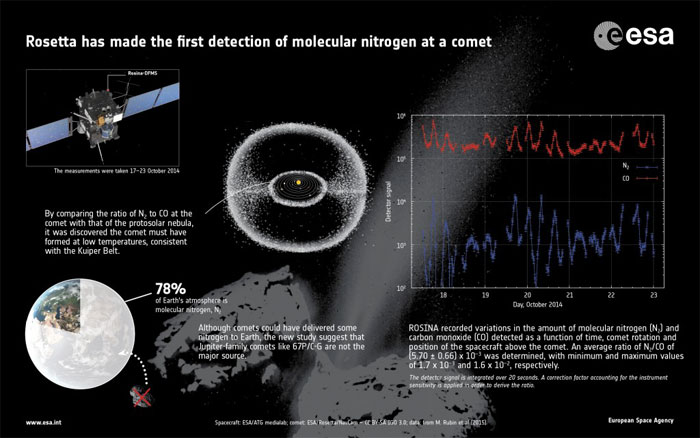
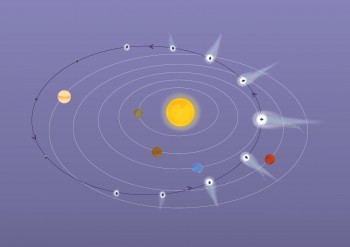
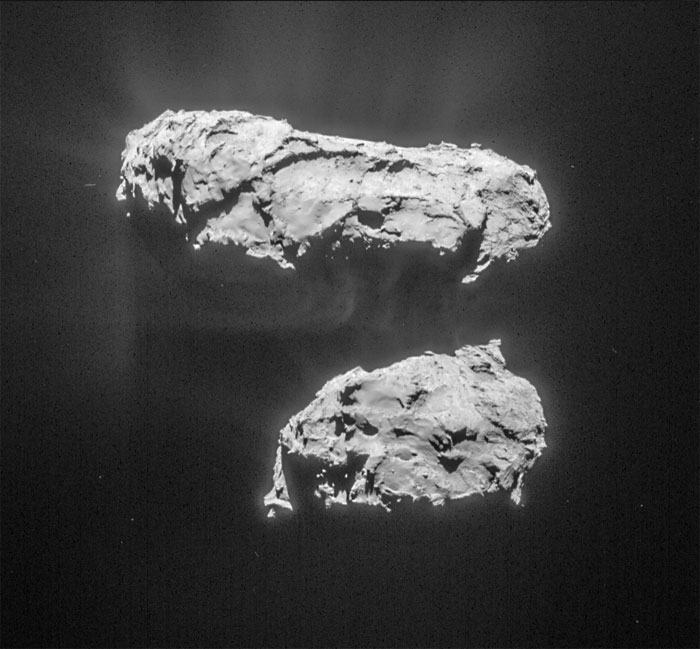
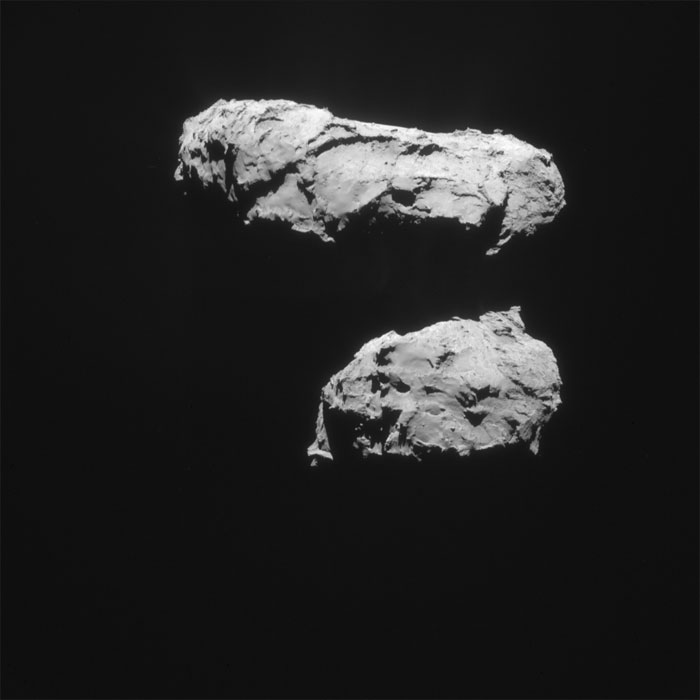
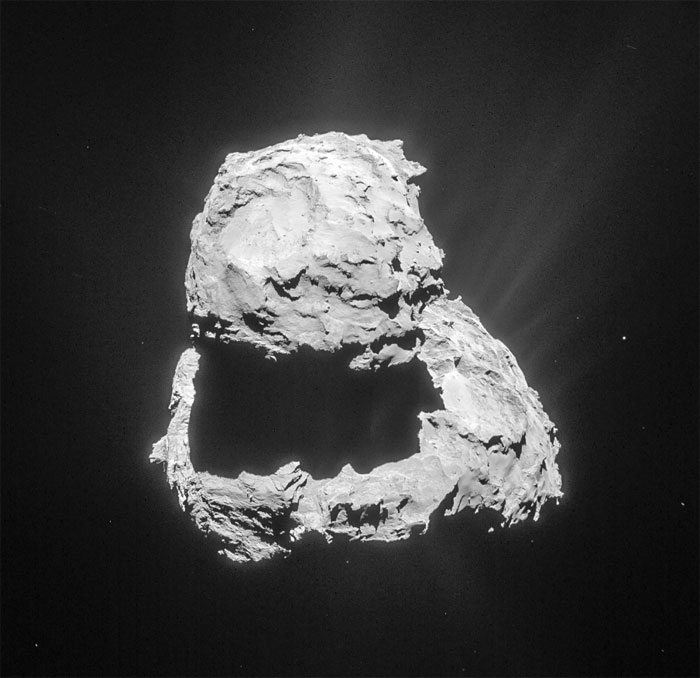
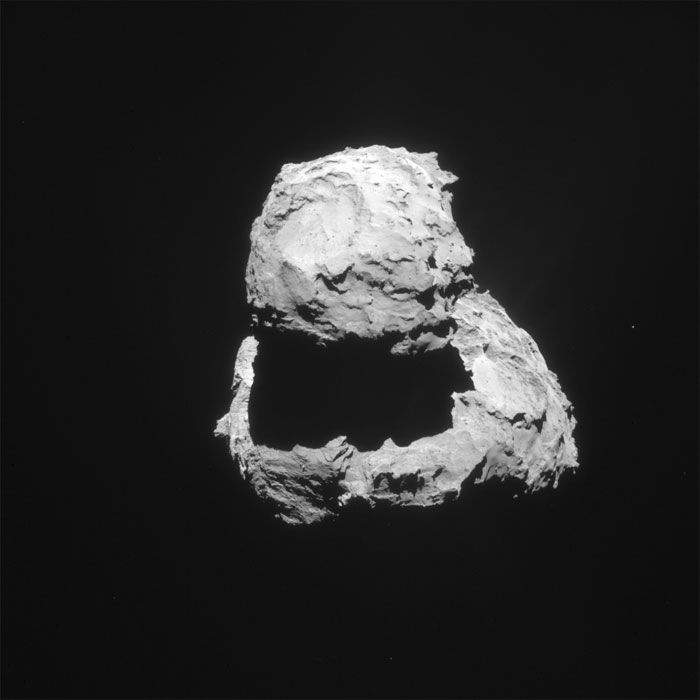
Additional 'phase angle coverage’ is useful to scientists studying a surface under different lighting conditions in the same way that a landscape artist, or photographer, studies a subject under different lighting conditions. Consider the classic English landscape artist John Constable, who used to study farms and/or mills at length, at different times of day, prior to finalizing a landscape (see the Tate Museum Constable exhibit for examples). Different lighting conditions (including those at ultraviolet and infrared wavelengths), bring out different features in terrain/foliage etc, as the reflectivity of any surface changes. It’s the reflectivity that is associated with different properties of the material the surface is made of, so seeing a surface under different conditions of light helps to define what those reflectivity properties are.
The ability to get really close to the comet nucleus for long periods of time allows those instruments that collect samples within an aperture to sample even more primitive material. The new scheme would enhance the ability of in situ instruments to gain signal as the spacecraft dipped closer, but the ability to study the nucleus under changing lighting conditions (particularly when the southern hemisphere starts to be exposed in southern summer) would be reduced. The SWT discussed the proposal at length and concluded that an approach in which terminator orbits are combined with those that can study lower phase orbits is the best compromise.
Observing 67P/C-G from Earth
As part of the SWT week, splinter workshops included that of the ground-based observing campaign, let by Colin Snodgrass, a UK cometary scientist at the Open University who leads (along with colleagues at ESO) the professional ground based campaign group (http://www.rosetta-campaign.net). Both amateurs and professionals are welcome to the meeting. The comet is currently behind the Sun, and will not be visible to professional ground-based observers until about June 2015 (just before perihelion). It is the hope that amateur astronomers will be able to observe the comet starting in the April-May timeframe. The US Rosetta Project manages the amateur ground-based observing program on behalf of the project. A new website is being designed, with a welcome page for amateur astronomers who are interested in participating in this exciting campaign. Web pages will soon be introduced at the JPL Rosetta web site, and a form for amateurs to fill out to register for the program. Instructions for how amateurs can upload (FITS Format) pictures will be included in a hand-book at that time.
Quelle: ESA
.
Update: 23.03.2015
.
ROSETTA MAKES FIRST DETECTION OF MOLECULAR NITROGEN AT A COMET
This news release is mirrored from the ESA portal, published on the occasion of the publication of the paper “Molecular nitrogen in comet 67P/Churyumov-Gerasimenko indicates a low formation temperature,” by M. Rubin et al. in the journal Science.
ESA’s Rosetta spacecraft has made the first measurement of molecular nitrogen at a comet, providing clues about the temperature environment in which Comet 67P/Churyumov–Gerasimenko formed.
Rosetta arrived last August, and has since been collecting extensive data on the comet and its environment with its suite of 11 science instruments.
The in situ detection of molecular nitrogen has long been sought at a comet. Nitrogen had only previously been detected bound up in other compounds, including hydrogen cyanide and ammonia, for example.
.

Its detection is particularly important since molecular nitrogen is thought to have been the most common type of nitrogen available when the Solar System was forming. In the colder outer regions, it likely provided the main source of nitrogen that was incorporated into the gas planets. It also dominates the dense atmosphere of Saturn’s moon, Titan, and is present in the atmospheres and surface ices on Pluto and Neptune’s moon Triton.
It is in these cold outer reaches of our Solar System in which the family of comets that includes Rosetta’s comet is believed to have formed.
The new results are based on 138 measurements collected by the Rosetta Orbiter Spectrometer for Ion and Neutral Analysis instrument, ROSINA, during 17–23 October 2014, when Rosetta was about 10 km from the centre of the comet.
“Identifying molecular nitrogen places important constraints on the conditions in which the comet formed, because it requires very low temperatures to become trapped in ice,” says Martin Rubin of the University of Bern, lead author of the paper presenting the results published today in the journal Science.
The trapping of molecular nitrogen in ice in the protosolar nebula is thought to take place at temperatures similar to those required to trap carbon monoxide. So in order to put constraints on comet formation models, the scientists compared the ratio of molecular nitrogen to carbon monoxide measured at the comet to that of the protosolar nebula, as calculated from the measured nitrogen to carbon ratio in Jupiter and the solar wind.
That ratio for Comet 67P/Churyumov–Gerasimenko turns out to be about 25 times less than that of the expected protosolar value. The scientists think that this depletion may be a consequence of the ice forming at very low temperatures in the protosolar nebula.
One scenario involves temperatures of between roughly –250ºC and perhaps –220ºC, with relatively inefficient trapping of molecular nitrogen in either amorphous water ice or cage-like water ice known as a clathrate, in both cases yielding a low ratio directly.
Alternatively, the molecular nitrogen could have been trapped more efficiently at even lower temperatures of around –253ºC in the same region as Pluto and Triton, resulting in relatively nitrogen-rich ices as seen on them.
.

Comet 67P/Churyumov-Gerasimenko is a Jupiter-family comet. Its 6.5 year journey around the Sun takes it from just beyond the orbit of Jupiter at its most distant, to between the orbits of Earth and Mars at its closest. The comet hails from the Kuiper Belt, but gravitational perturbations knocked it towards the Sun where interactions with Jupiter’s gravity set it on its present-day orbit. Credits: ESA
.
Subsequent heating of the comet through the decay of radioactive nuclides, or as Rosetta’s comet moved into orbits closer to the Sun, could have been sufficient to trigger outgassing of the nitrogen and thus a reduction of the ratio over time.
“This very low-temperature process is similar to how we think Pluto and Triton have developed their nitrogen-rich ice and is consistent with the comet originating from the Kuiper Belt,” says Martin.
The only other body in the Solar System with a nitrogen-dominated atmosphere is Earth. The current best guess at its origin is via plate tectonics, with volcanoes releasing nitrogen locked in silicate rocks in the mantle.
However, the question remains as to the role played by comets in delivering this important ingredient.
“Just as we wanted to learn more about the role of comets in bringing water to Earth , we would also like to place constraints on the delivery of other ingredients, especially those that are needed for the building blocks of life, like nitrogen,” says Kathrin Altwegg, also at the University of Bern, and principal investigator for ROSINA.
To assess the possible contribution of comets like Rosetta’s to the nitrogen in Earth’s atmosphere, the scientists assumed that the isotopic ratio of 14N to 15N in the comet is the same as that measured for Jupiter and solar wind, which reflects the composition of the protosolar nebula.
However, this isotopic ratio is much higher than measured for other nitrogen-bearing species present in comets, such as hydrogen cyanide and ammonia.
Earth’s 14N/15N ratio lies roughly between these two values, and thus if there was an equal mix of the molecular form on the one hand, and in hydrogen cyanide and ammonia on the other in comets, it would be at least conceivable that Earth’s nitrogen could have come from comets.
“However, the amount of nitrogen found in 67P/Churyumov–Gerasimenko is not an equal mix between molecular nitrogen and the other nitrogen-bearing molecules. Rather, there is 15 times too little molecular nitrogen, and therefore Earth’s 14N/15N ratio cannot be reproduced through delivery of Jupiter family comets like Rosetta’s,” says Martin.
“It’s another piece of the puzzle in terms of the role of Jupiter-family comets in the evolution of the Solar System, but the puzzle is by no means finished yet,” says ESA’s Rosetta project scientist, Matt Taylor.
“Rosetta is about five months away from perihelion now, and we’ll be watching how the composition of the gases changes over this period, and trying to decipher what that tells us about the past life of this comet.”
Notes
“Molecular nitrogen in comet 67P/Churyumov-Gerasimenko indicates a low formation temperature,” by M. Rubin et al is published in the 20 March issue of the journal Science. 10.1126/science.aaa6100
ROSINA is the Rosetta Orbiter Spectrometer for Ion and Neutral Analysis instrument and comprises two mass spectrometers: the Double Focusing Mass Spectrometer (DFMS) and the Reflectron Time of Flight mass spectrometer (RTOF) – and the COmetary Pressure Sensor (COPS). The measurements reported here were conducted with DFMS. The ROSINA team is led by Kathrin Altwegg of the University of Bern, Switzerland.
An average ratio of N2/CO = (5.70 +/-0.66) x 10–3 was determined for the period 17–23 October 2014. The minimum and maximum values measured were 1.7 x 10–3 and 1.6 x 10–2, respectively. Because the amount and composition of the gases change with comet rotation and position of the spacecraft with respect to the comet’s surface, an average value is used.
The 14N/15N ratio for the N2 in Comet 67P/Churyumov–Gerasimenko is assumed to be 441, the value for the protosolar nebula as measured from Jupiter and the solar wind, while the corresponding value for nitrogen in hydrogen cyanide and ammonia is 130, as measured at other comets. The value for the Earth’s nitrogen is 272.
.
COMETWATCH 14 MARCH – 6 HOURS LATER
This single frame NAVCAM image was taken on 14 March at a distance of 81.4 km from the centre of Comet 67P/Churyumov-Gerasimenko. At this distance, the resolution of NAVCAM is 6.9 m/pixel. The image is cropped and measures 6.4 × 5.9 km (the original picture, uncropped, is provided at the end of the post and measures 7.1 km across).
.

Cropped and processed single frame NAVCAM image of Comet 67P/C-G taken on 14 March 2014 from a distance of 81.4 km to the comet centre. Credits: ESA/Rosetta/NAVCAM – CC BY-SA IGO 3.0
.
The image was taken on the same day as Wednesday's CometWatch entry, but six hours later – roughly half a comet day. In this unusual orientation, the comet's large lobe is up and the small lobe down, while the neck region is cast in shadows.
The Lightroom processed version shows beautiful structures of outflowing material from the neck, as well as from the large lobe. There is also a more general ‘glow’ around the comet, suggestive of generally increasing activity all over the surface. Finally, the large lobe can be seen casting a shadow over the nebulosity beneath it.
On the large lobe, another striking feature catches the eye: the Aten region, an elongated depression between Ash, to the left, and Khepry, to the right.
The original 1024 x 1024 pixel frame is provided below (click on the image for full resolution):
.

Quelle: ESA
.
COMETWATCH 18 MARCH
This single frame NAVCAM image was taken on 18 March at a distance of 81.4 km from the centre of Comet 67P/Churyumov-Gerasimenko.
The image scale of the original 1024 x 1024 pixel image is 6.9 m/pixel and the image measures 7.1 km across; a cropped, processed version is shown below.
.

Cropped and processed single frame NAVCAM image of Comet 67P/C-G taken on 18 March 2015 from a distance of 81.4 km to the comet centre. This cropped version measures about 6.2 km across. Credits: ESA/Rosetta/NAVCAM – CC BY-SA IGO 3.0
The image is processed to bring out the outflowing material while not overexposing the nucleus too much. Indeed, in this image, a few faint but distinct jets of material can be seen rising above the comet’s larger lobe, with a diffuse nebulosity visible around the entire nucleus.
A labelled image is also provided to point out some of the regions on the comet’s surface. In this orientation we can see portions of the larger lobe emerging from the shadows – in particular parts of Aker and Babi – that in many previous images have been obscured by shadows cast by the comet’s smaller lobe.
The original 1024 x 1024 pixel image is provided below:
.

Quelle: ESA
-
Update: 25.03.2015
-
IMHOTEP UP – COMETWATCH 20 MARCH
This single frame NAVCAM image was taken on 20 March 2015 at a distance of 81.7 km from the centre of Comet 67P/Churyumov-Gerasimenko. The image scale of the original 1024 x 1024 pixel image is 7 m/pixel and the image measures 7.1 km across; a cropped, processed version is shown below.
.
5025 Views
